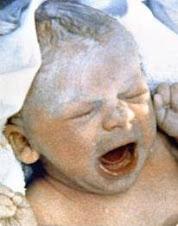As I approach my 30th birthday, having delayed marriage and children, the social and biological clock of keeping time for childbearing ticks louder. However, thanks to another 30-year-old woman, it's possible for me to feel at ease. That woman is Louise Brown, the first child born via IVF. Last week marked not only her 30th birthday but thirty years of success in giving many women and men a second chance to have a biologically-related (at least, in part) child of their own. In fact, over 3 million babies worldwide have been born using IVF -- with over 52,000 infants born in the US, accounting for 1 percent of all births in the country.
In conversations with my close friends, it's been comforting to hear that we share the same concerns about starting a family later in life. We joke that after years of being on birth control--from condoms to pills to patches and rings and back to condoms again--diligently trying to avoid an unplanned pregnancy, we're fearful that we may, in fact, experience infertility.
Because of assisted reproduction and the tremendous successes gained in the past three decades, the clock is not ticking as loudly for me as it was for my mother. Instead, my generation has grown accustomed to this $3 billion industry--most of us know at least one friend, family member or colleague who has been through IVF. But this familiarity brings with it a whole new set of concerns. What are the ethical, moral, legal and financial impacts of this field? How do we grapple with these issues as a women's community, before others tell us what's best for our bodies and for our children? We've seen it before, and it will happen again.
It is incumbent upon the women's reproductive health community, particularly those who face these issues daily, to foster this debate. We might begin with the following concerns:
Number 1: Why is my generation of women and men more infertile than our parents? Currently, in the US, 1.2 million (or 2%) of women of reproductive age (defined by the CDC as age 10 to 49) have an infertility-related medical appointment each year; 10% receive infertility services at some point in their lives. As I've alluded, a big factor is age. To simplify things greatly, as more women gained equality in education and in the workplace, we also began to delay childbearing--for many reasons, including lack of maternity leave and inflexible work schedules.
But to highlight only age would be misleading. With so many individuals experiencing infertility (and in cases in which the underlying causes are never found), we cannot ignore the tremendous role that environmental contaminants are playing in this problem.
Exposure to ubiquitous dioxins, such as cigarette smoke, lead, mercury and some agricultural pesticides are direct threats to a couple's ability to conceive or have a healthy pregnancy. And, more troubling, new research suggests that a broader range of chemicals--including many that are associated with everyday products such as household cleansers, flame retardants, personal care and beauty aids, and even plastic water bottles--could have a complex and far-reaching impact on fertility.
Number 2: Are these procedures--the hormones, the retrieval of eggs, the implantation of one or multiple embryos--safe for women and their children? The answer, for the most part, is that we don't know. While IVF has generally been accepted as safe by the American public, there are in fact very little published data, let alone quality, standardized data, on the short and long term safety of these procedures on women and children's health. As we see an increase in women going through these procedures for either their own reproduction or to donate their eggs, how can we fully inform them of the potential risks and benefits?
Number 3: The growth of this industry and the growth in the numbers of assisted fertility clinics (now at 475 in total) have increased the demand for women's eggs. While most clinics offer women an average of $3,000 to $8,000, some "baby brokers" have offered as much as $50,000-80,000 for specific egg donors. (The American Society for Reproductive Medicine's (ASRM) guidelines allow for women to be compensated for their time and risk up to $5,000 or $10,000 in some cases, but this is neither mandated nor regulated by either state or federal law.) This issue poses its own ethical and moral dilemmas: should a woman be compensated for donating her eggs? Can payment create a coercive or exploitative situation? What are the race and class implications of who demands and who gets solicited for their eggs?
As with many momentous events in my life, as I approach my 30th birthday, I'm asking myself more questions than I know answers. I have found that asking questions--and listening to a broad range of voices who have their own personal and insightful answers--is the first step in the process in advocating for change. We must grapple with these issues and then propose solutions that follow our values and morals. So, in that vein, my parting question: what policies will empower all women to make their own decisions about having a child and yet protect her health? The answer to this will be the best 30th birthday present for me and Louise.
Jennifer Rogers






